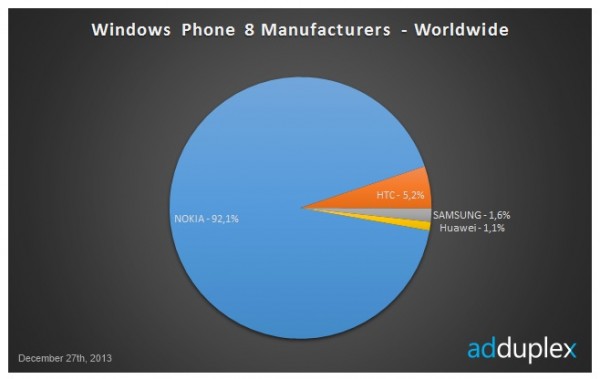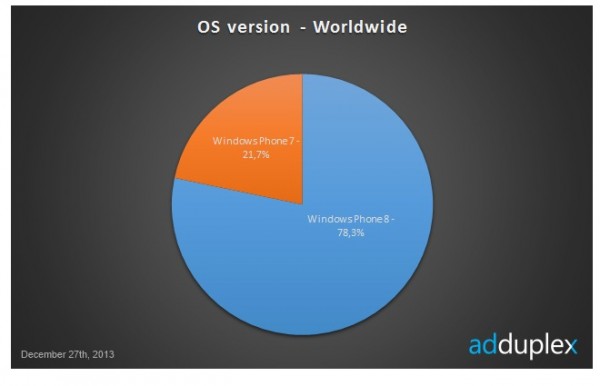AdDuplex December: Nokia >92% of WP; are other OEM’s still needed? #Ramble

Quick heads up on some stats from AdDuplex, showing the continuing rise of Nokia’s share in WP. This would of course gain more significance if there was some considerable growth in the WP market. Crossing over to stats from Kantar Worldpanel, there is some decent growth for WP, particularly in Europe where it’s now on double digits for the big EU5.
http://blog.adduplex.com/2013/12/adduplex-windows-phone-statistics.html
Does MS need anyone other than Nokia? Why is Nokia having such a lead? Â
At over 92%, Nokia is pretty much WP. Does MS need the other OEMs? I’d say at the start, it was very important to have multiple manufacturers who are able to assist Nokia/WP grow by providing devices that Nokia didn’t have at the time. Now, Nokia is producing new members of the family filling the segments so that consumers have more choices “WP” choices. Having competition at the start initially worried some as they felt Nokia wouldn’t be able to compete with the likes of Samsung and HTC, or displace either two at WP, especially given HTC’s head start. That was a reasonable worry but something Nokia has overcome (that and the other OEMs pretty much rolled over and gave up with their offerings). I think at around the 80% mark, there were reports of some manufacturers in Asia not wanting to pick up WP as the competition (Nokia) was too strong. Or perhaps WP still isn’t that big enough for the other larger OEMs to put significant thought?
It’s not odd that a single manufacturer would have such a large share in an OS. Remember Nokia in Symbian when Symbian had plenty of other OEMS and was on the rise? Also currently Samsung – >70% of Europe’s Android (?) >40% worldwide (?). The Symbian/Android contrast are examples that one manufacturer can dominate if their portfolio is strong enough, but also towards the end stages of Symbian that a manufacturer can also dominate if all the others (Moto/Samsung/SE etc) give up on the platform. The latter is not what we want, as Nokia fans (especially not those who are a fan of the platform). Not yet at least until WP/Nokia Lumia is solidly on its feet amongst the market and consumers. Though they are ‘definitively’ in third, a healthy, growing ecosystem needs multiple partners.
Perhaps it isn’t so simple to state that an OS rigidly needs multiple manufacturers. It’s easy enough to give examples supporting one or the other, e.g. iOS for Apple which is successful, vs BlackBerry OS for Blackberry which is less so. Apple is different in the way their products are perceived and I don’t have the time to address that in my ramble. Basically, Apple broke through Symbian’s weakened defences (the OS just wasn’t improving at the rate we needed it, and thus was limiting the device in hardware as well as software experiences). Symbian showed one way to have a smartphone experience with a multitude of features but iOS made the basic experiences accessible to the average Joe (though at a price, which we know now, a growing amount of people accepted). It wasn’t until Android started replicating some of that simplified touch experience at Symbian’s lower price points that we saw Symbian truly in trouble.
Experiences wise, the OSes are pretty much ‘equal’ in having strengths and weaknesses. There are obvious areas where WP can improve on (there are still some features we are asking for, and of course the app issue) but for the majority of consumers, things are even. It’s now mainly down to perception of what devices people should go for. Perhaps if Symbian had sufficiently matured (or Nokia was predominantly on Maemo) things would be different as Nokia could fight even alone with solid software and hardware?
So, going back to the original question then, are other OEM’s still needed(In the phone space)? Perhaps MS finds that WP is indeed solid enough to go it alone. Back in September, when questioned whether other OEMs would be scared of the deal, Ballmer didn’t really answer the question directly as you might expect. Compare his reaction to the Google acquisition of Motorola Mobility which Google aimed at strengthening other partners. Here, Ballmer simply states that Nokia is >80% of WP and that they are in a position to accelerate it further. He indicates partners in tablets and PC are important. He doesn’t say anything about phones other than MS accelerating phones through Nokia is only good at strengthening the PC/Tablet. He says partners in ‘Tablet/PC’ seem quite enthusiastic. No mention of the phone manufacturers. With Nokia D&S soon to be under MS’ wings, MS can fully control both software and hardware side. Fear of alienating partners may be balanced by the fact that now over 92% of the platform is from one manufacturer – and through that one manufacturer they are breaking through the market (though very slowly). Were MS acquiring HTC instead of Nokia, then they might of course have fears of pushing the stronger competitors (Nokia) away.
It’s interesting to note that Elop used the Google acquisition of Motorola to signal danger ahead for other Android OEMs, whilst also being bringing further importance to the Nokia-MS deal and even being a potential catalyst to the platform.
If I happened to be someone who was an Android manufacturer or an operator, or anyone with a stake in that environment, I would be picking up my phone and calling certain executives at Google and say ‘I see signs of danger ahead

From 2011. Prior to the first Lumia.
‘Anyone with a stake in the environment’ – the only one with a stake at WP is really Nokia. All others at this point, MS might find ‘negligible’. WP=Nokia Lumia and the success of ‘Nokia’ Lumia is the future of MS as a successful D&S company.
- Nokia and Microsoft together will accelerate innovation and choice in mobile computing. Consumers will get better phones at lower prices
- Nokia Corp in 2011 made a big bet on WP as the sole operating system for all its smartphone devices.
- Microsoft is great at software; Nokia Corp. is great at devices. The combination of the two makes sense and will enable faster innovation.
- Nokia Corp has a long history of innovation in communications technology and the development of intellectual property
- Source? http://www.google.com/press/motorola/ (some words replaced)

Back to AdDuplex…
Regarding devices, the 520 and the 920 top most segments per region, sometimes swapping order. Whilst it is important to see good sales of the higher end devices, the entry level 52x is nothing to be scoffed at as it provides the perfect foot in the door to the Nokia Lumia portfolio. Folks willing to pay more may get better hardware perks, but the user experience of the OS is consistently fluid throughout the family and hence why the entry level lumias have been praised as such
Hopefully the likes of the 1520 and 1020 continue to raise the image of the brand (Nokia/Lumia, obviously no one is really looking at them as WP other than us mobile geeks) and that halo trickles down to the other devices. Handsets like the 1320, 635 (unannounced) and 525 should lift this whole ecosystem even further by bringing incredible value.
Category: Nokia





Connect
Connect with us on the following social media platforms.